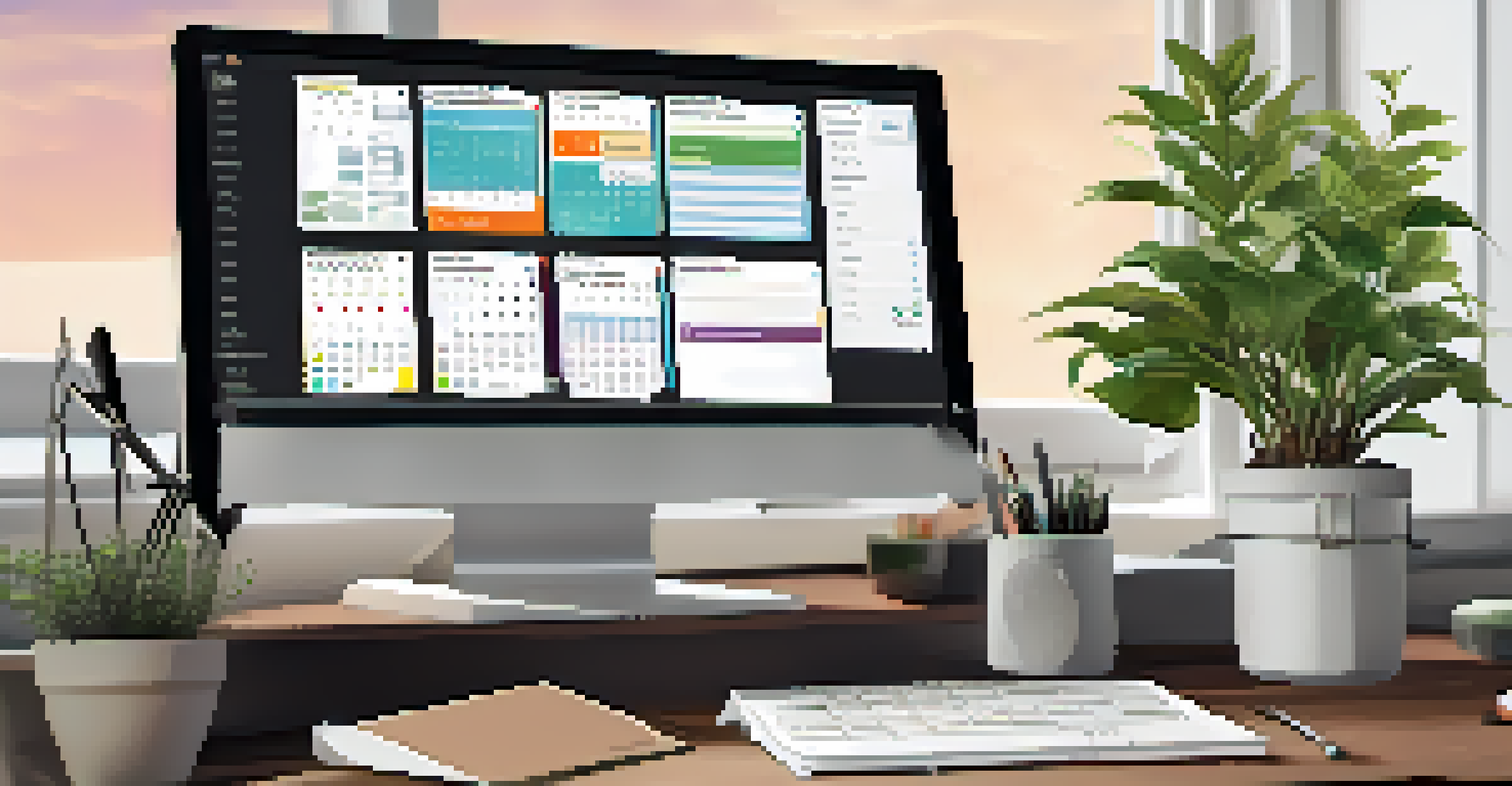Balancing Remote Work and Personal Life Effectively

Understanding the Challenges of Remote Work-Life Balance
Remote work offers flexibility, but it can blur the lines between work and personal life. Many remote workers find themselves responding to emails late at night or working on weekends, leading to burnout. It's crucial to recognize these challenges to address them effectively.
The key is not to prioritize what's on your schedule, but to schedule your priorities.
Without a clear distinction between work hours and personal time, it’s easy to feel overwhelmed. Imagine living in a house where the office is always open; it can be hard to relax! Acknowledging that this is a common struggle is the first step toward finding balance.
By understanding these challenges, we can better prepare ourselves to create boundaries that protect our personal time. After all, a healthy work-life balance is essential for long-term productivity and well-being.
Creating a Dedicated Workspace at Home
Designating a specific area in your home as your workspace can significantly improve your focus and productivity. This doesn't mean you need an entire room; a corner of your living room or a cozy nook can suffice. The key is to create an environment that signals 'work mode' when you enter it.

Think of your workspace as a stage where you perform your professional duties. When you step onto this stage, you’re in work mode, and when you step off, it’s time to switch to personal time. This physical separation can help reinforce mental boundaries.
Set Boundaries for Work Hours
Establishing clear working hours helps maintain a healthy work-life balance and signals availability to others.
Additionally, personalizing your workspace with items that inspire you can enhance your motivation. Whether it’s a favorite mug or a motivational poster, these small touches can make your workspace feel inviting and encourage productivity.
Establishing Clear Working Hours
Setting clear working hours is one of the most effective ways to maintain a work-life balance. It helps you stay disciplined and signals to others when you are available and when you are not. Communicating these hours to your team or family is crucial for mutual respect.
You can’t do a good job if your job is all you do.
Consider using a calendar to block out your work hours, just like you would for an in-office job. This visualization helps you commit to your schedule and resist the temptation to work outside those hours. It’s like having a 'do not disturb' sign for your personal time.
Remember, it’s important to stick to these hours as much as possible. Treating your work hours with the same seriousness as a traditional job can help you maintain that crucial balance between work and personal life.
Incorporating Breaks into Your Workday
Taking regular breaks is essential for maintaining productivity and mental clarity while working from home. It’s tempting to power through your tasks, but just like a runner needs to rest, so do you! Short breaks can rejuvenate your mind and prevent burnout.
Try techniques like the Pomodoro Technique, where you work for 25 minutes followed by a 5-minute break. This approach can help you stay focused while ensuring you take time for yourself. Think of it as a sprint followed by a refreshing breather.
Create a Dedicated Workspace
Designating a specific area for work can improve focus and reinforce the mental separation between work and personal life.
Use your breaks to do something enjoyable, like stretching, grabbing a snack, or stepping outside for fresh air. These activities can recharge your energy and improve your overall mood, making you more effective when you return to work.
Embracing Technology to Stay Organized
Leveraging technology can significantly enhance your ability to balance remote work and personal life. Tools like project management apps and calendars can help you keep track of tasks and deadlines, ensuring nothing slips through the cracks. It's like having a personal assistant at your fingertips!
By organizing your tasks digitally, you can visually separate work responsibilities from personal commitments. This clarity helps to reduce stress and allows you to allocate time effectively for both areas of your life.
Additionally, use technology to set reminders for personal activities, such as family dinners or exercise routines. This proactive approach ensures that your personal life gets the attention it deserves amidst your work responsibilities.
Setting Boundaries with Family and Friends
Communicating your work schedule and boundaries to family and friends is vital in maintaining a healthy balance. When they understand your working hours, they’re less likely to interrupt you during important tasks. It’s similar to having a 'quiet time' rule in a library—everyone respects the space.
Encourage your loved ones to support your work time by helping them understand the importance of focus during those hours. You could even establish a signal, like a closed door, to indicate when you're busy. This simple gesture communicates that while you’re at home, you’re still at work.
Prioritize Self-Care Regularly
Engaging in self-care activities is essential for reducing stress and enhancing overall well-being while working remotely.
On the flip side, make sure to carve out dedicated time for social interactions outside of work hours. This balance helps you recharge emotionally and strengthens your relationships, which is just as crucial for your overall well-being.
Practicing Self-Care for Mental Well-Being
Prioritizing self-care is key to maintaining a healthy work-life balance while working remotely. Engaging in activities you love, whether it's reading, exercising, or pursuing a hobby, can significantly boost your mood and reduce stress. Think of it as recharging your phone; without it, you’ll run out of energy!
Set aside time each week dedicated solely to self-care. This could be a long walk, a movie night, or even a spa day at home. By scheduling it in, you ensure that you make time for your well-being amidst your busy work schedule.

Remember, self-care isn't selfish; it's essential for your productivity and happiness. When you take care of yourself, you’ll find that you're more present and engaged in both your work and personal life.
Reflecting and Adjusting Your Balance Regularly
Finding the right balance is an ongoing process that requires reflection and adjustment. Regularly check in with yourself to assess how well your current strategies are working. Just like tuning a musical instrument, fine-tuning your approach can help you hit the right notes in your daily life.
Consider keeping a journal or notes on your experiences to identify what works and what doesn’t. This practice can provide valuable insights into your habits and help you make necessary changes. It’s a personal roadmap to balance!
Don't be afraid to experiment with new strategies or adjust your existing ones. Life is dynamic, and so should be your approach to balancing remote work and personal life. Embracing flexibility will lead you to a more harmonious lifestyle.